17 janv 2026
KCF Est :
Oryzias & Galette des rois.
En savoir +
25-26 janv 2026
KCF Pays de la Loire :
Bourse de Jardres
31 janv 2026
KCF Normandie :
Réunion de section "Galette des Rois"
En savoir +
31 janv - 1 fév
Section Pyrénées :
Bourse de Blagnac
8-10 mai 2026
SEK Espagne :
Congrès de la SEK 2026
14-17 mai 2026
Allemagne DKG :
Congrès de la DKG 2026
25-27 sep 2026
KCF France :
52ème congrès du KCF
Fermer 
Accueil
Qu'est ce que le KCF ?
Les sections régionales
Les congrès du KCF
Contacter le KCF
L'agenda du KCF
Les liens du KCF
Challenge Européen Killiphile
Débuter avec les killies
Les actualités du KCF
Interviews d'éleveurs
Bricolage et astuces
Nourriture
Voyages / Expéditions Killi Expert
Annonces
Voyages / Expéditions Killi Expert
- Accueil
- Le forum du KCF
- Les killies : maintenance, reproduction et élevage
- Aphanius mento Zengen
Aphanius mento Zengen
Les killies : maintenance, reproduction et élevage

Le 17 mai 2011 à 22h39

BigC
Le 17 mai 2011 à 22h39
[b]Here's looking at you kid!.........[/b]
Apologies for being late with this instalment, I've just got in from work so things have been a little rushed.
Tonight I wanted to concentrate on the eye of the embryo as this is the area in which there seems to have been a lot of development in the last 24 hours or so.
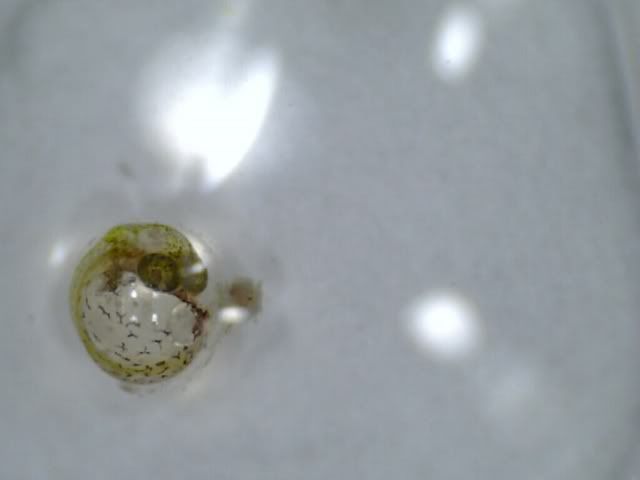
[color=red]Day 12 [/color]As you can see from the above image, the eyes are becoming a more prominent feature these days.
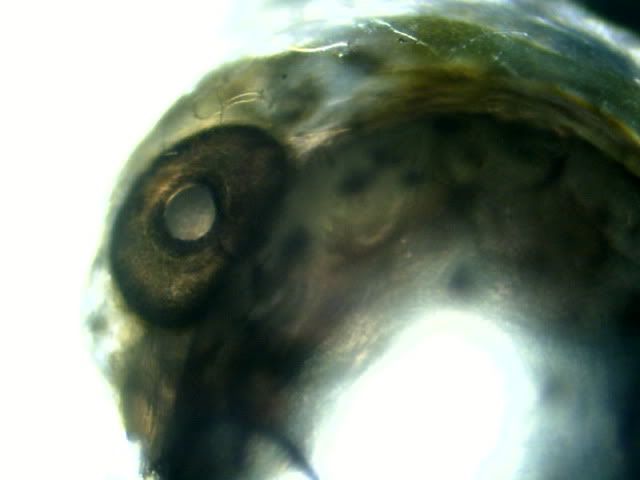
Seen again in close-up from the microscope, they are forming nicely. Going by other killifish eggs I have studied, when the eyes are fully formed then hatching is imminent.
Aphanius mento Embryo Day 12
The video is little hurried I'm afraid, but I think you can still make out the main organ pumping away with the eye to the top right of the picture.
Hopefully tomorrow I will get more time to spend on this interesting subject, thanks for looking :)
Regards
C
Apologies for being late with this instalment, I've just got in from work so things have been a little rushed.
Tonight I wanted to concentrate on the eye of the embryo as this is the area in which there seems to have been a lot of development in the last 24 hours or so.

[color=red]Day 12 [/color]As you can see from the above image, the eyes are becoming a more prominent feature these days.

Seen again in close-up from the microscope, they are forming nicely. Going by other killifish eggs I have studied, when the eyes are fully formed then hatching is imminent.
Aphanius mento Embryo Day 12
The video is little hurried I'm afraid, but I think you can still make out the main organ pumping away with the eye to the top right of the picture.
Hopefully tomorrow I will get more time to spend on this interesting subject, thanks for looking :)
Regards
C

Le 18 mai 2011 à 21h00

BigC
Le 18 mai 2011 à 21h00
First Blood!......
The one quite noticeable discovery this evening is that the egg casing in not as clear and transparent as before, getting a good video shot is getting increasingly more difficult to get good footage through this crystalline mist. It's taking quite a bit of time in order to position the egg to get hold of just a few frames. Not too sure why this is, perhaps someone can enlighten me. The embryo inside the egg casing remains alive and healthy and the heart area is much reddened and I think maybe all the accelerated processes from the early few days have slowed down somewhat, well, that is to the eye of a non scientific person at least. Growth looks to be the main factor from now on in.
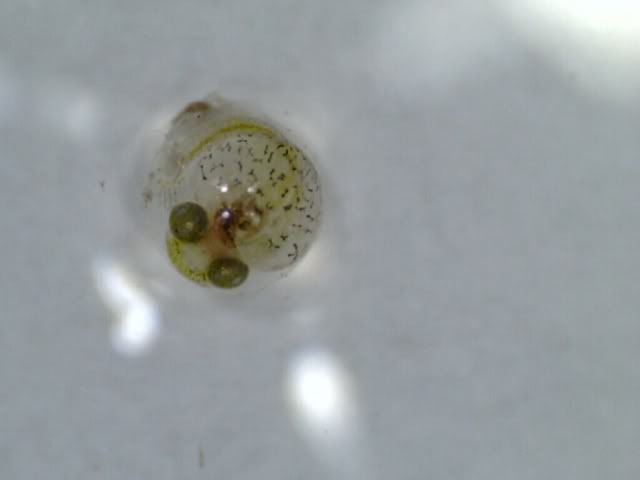
[color=red]Day 13[/color] Another little overhead shot, showing the whole of the egg and its valuable contents within. One can clearly see that around the heart and aft of the head area, this whole expanse has taken on a deeper shade of red.
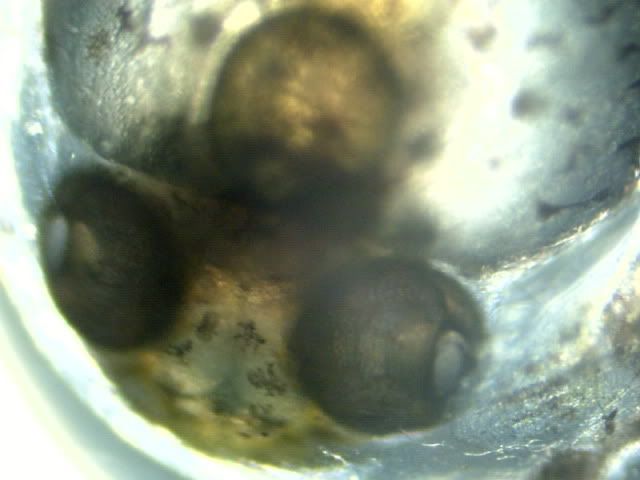
From the microscopic close-up shot we can see both the eyes which appear much larger today
http://www.youtube.com/watch?v=MjTBd5m-yXw#
Not wishing to bore you all with another heartbeat shot, these few frames denote the fluids that are being forced around the membrane area of the egg.
Regards
C
The one quite noticeable discovery this evening is that the egg casing in not as clear and transparent as before, getting a good video shot is getting increasingly more difficult to get good footage through this crystalline mist. It's taking quite a bit of time in order to position the egg to get hold of just a few frames. Not too sure why this is, perhaps someone can enlighten me. The embryo inside the egg casing remains alive and healthy and the heart area is much reddened and I think maybe all the accelerated processes from the early few days have slowed down somewhat, well, that is to the eye of a non scientific person at least. Growth looks to be the main factor from now on in.

[color=red]Day 13[/color] Another little overhead shot, showing the whole of the egg and its valuable contents within. One can clearly see that around the heart and aft of the head area, this whole expanse has taken on a deeper shade of red.

From the microscopic close-up shot we can see both the eyes which appear much larger today
http://www.youtube.com/watch?v=MjTBd5m-yXw#
Not wishing to bore you all with another heartbeat shot, these few frames denote the fluids that are being forced around the membrane area of the egg.
Regards
C

Le 19 mai 2011 à 20h11

BigC
Le 19 mai 2011 à 20h11
[b]Poorer visibility....[/b]
I think my assumptions are correct when I say that the egg membrane is becoming slightly more difficult to see through clearly, at least not as clearly as in the early days in the life-cycle of this egg. This got me to wondering about things, as you do....How actually does the fry burst free from the egg casing. Is there some sort of erosion from within (attributed to the fry itself). Does the fry just get so big that the casing ruptures. Are there outside elements that have a bearing on all of this like the alien lifeforms we looked at previously, do they weaken the cocoon aiding the fry to escape it's confines. Or does the membrane have a mechanism all of its own that gradually degrades over time.
If anyone would like to comment on any of my pondering's above please feel free to participate and interact in discussion
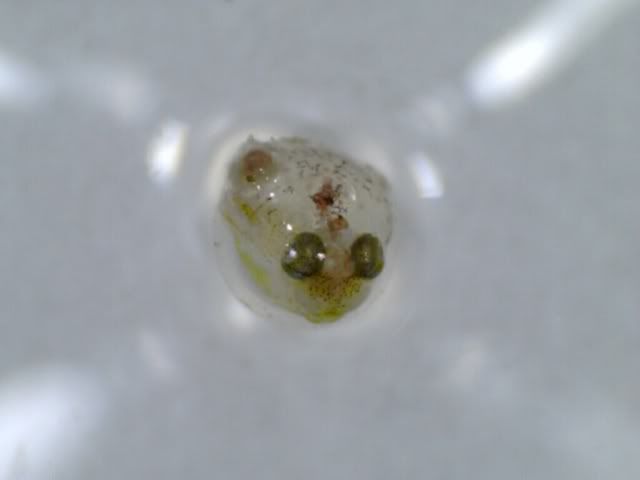
[color=red]Day 14[/color] The embryo is still alive and well inside it's protective shield.
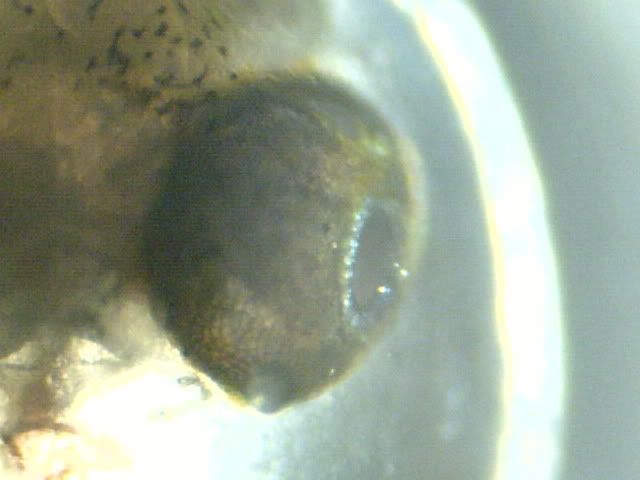
What big eyes you've got!...The optics are very large now and are starting to show better definition whilst an iridescence ring is becoming more and more prominent around what will be the iris.
http://www.youtube.com/watch?v=c1tAi4jXr3g#
Like some kind of living alien planet from a Si-Fi movie, the heart continues to perform it's primary task. It has settled into a much sedate but purposeful rhythm pattern not seen in its earlier development stages.
Again any queries, suggestions or criticisms are always welcomed.
Thanks for taking an interest
Regards
C
I think my assumptions are correct when I say that the egg membrane is becoming slightly more difficult to see through clearly, at least not as clearly as in the early days in the life-cycle of this egg. This got me to wondering about things, as you do....How actually does the fry burst free from the egg casing. Is there some sort of erosion from within (attributed to the fry itself). Does the fry just get so big that the casing ruptures. Are there outside elements that have a bearing on all of this like the alien lifeforms we looked at previously, do they weaken the cocoon aiding the fry to escape it's confines. Or does the membrane have a mechanism all of its own that gradually degrades over time.
If anyone would like to comment on any of my pondering's above please feel free to participate and interact in discussion

[color=red]Day 14[/color] The embryo is still alive and well inside it's protective shield.

What big eyes you've got!...The optics are very large now and are starting to show better definition whilst an iridescence ring is becoming more and more prominent around what will be the iris.
http://www.youtube.com/watch?v=c1tAi4jXr3g#
Like some kind of living alien planet from a Si-Fi movie, the heart continues to perform it's primary task. It has settled into a much sedate but purposeful rhythm pattern not seen in its earlier development stages.
Again any queries, suggestions or criticisms are always welcomed.
Thanks for taking an interest
Regards
C

Le 20 mai 2011 à 21h54

BigC
Le 20 mai 2011 à 21h54
[b]Heads or Tails![/b]......
Tonight's instalment on this topic allows me to focus on the caudal fin area of the embryo. Although I knew from the outset that it was going to be a pretty difficult task to capture this, as it is still a very small part of the anatomy of this embryo at this moment, but one that is of uppermost importance if it is to propel itself through its future watery environment.
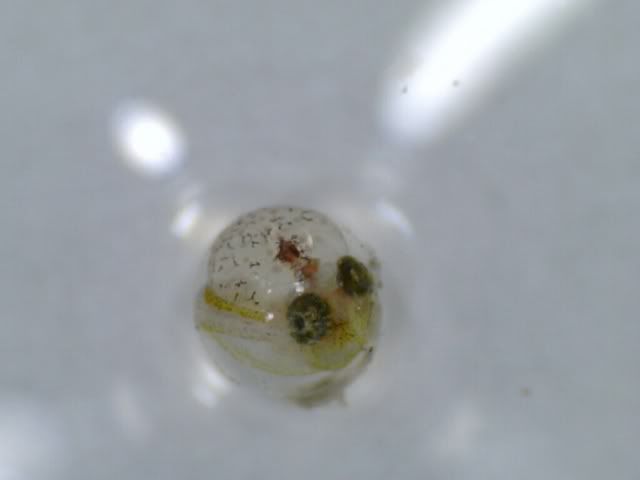
[color=#FF0000]Day 15.[/color]..our overall shot of the egg shows the tail wrapped around in front of the eye. If you look to the right of the iris you will notice some fine white flecks...these are actually the rays of the caudal fin

In our secondary image from this evening you may just be able to make out these flecks or rays, on top of the black area surrounding part of the eye.
Today's video footage takes a look at the spine area of the embryo, directly behind the enlarged head...the nape or neck if you like.
It shows two main channels of fluid movement. The uppermost channel seems to move along in pulses whereas the lower channel seems to have more of a constant flow about it
Regards
C
Tonight's instalment on this topic allows me to focus on the caudal fin area of the embryo. Although I knew from the outset that it was going to be a pretty difficult task to capture this, as it is still a very small part of the anatomy of this embryo at this moment, but one that is of uppermost importance if it is to propel itself through its future watery environment.

[color=#FF0000]Day 15.[/color]..our overall shot of the egg shows the tail wrapped around in front of the eye. If you look to the right of the iris you will notice some fine white flecks...these are actually the rays of the caudal fin

In our secondary image from this evening you may just be able to make out these flecks or rays, on top of the black area surrounding part of the eye.
Today's video footage takes a look at the spine area of the embryo, directly behind the enlarged head...the nape or neck if you like.
It shows two main channels of fluid movement. The uppermost channel seems to move along in pulses whereas the lower channel seems to have more of a constant flow about it
Regards
C

Le 21 mai 2011 à 20h31

BigC
Le 21 mai 2011 à 20h31
[b][color=red]De nouveau, je fais des excuses que ce fil n'est pas dans votre propre langue française. J'espère qu'il ne vous a pas gâtés le plaisir de cela.[/color][/b]
[b]Sweet Little Sixteen[/b]...
Yes its day sixteen in the life of this little embryo, I don't think there is too long to go now. The opalescence around the iris is really prominent now and as I mentioned previously, that I think when this is fully formed then hatching is imminent. The embryo is large and it possesses a large sac, probably some kind of yolk sack or bladder, this it will carry with it for a few days even after hatching before the fry trims off somewhat. This aspect is much more pronounced in this species than any fry I've previously kept and looked at. It really is large and extended, so much so you would say that the fry hatched pre-maturely.
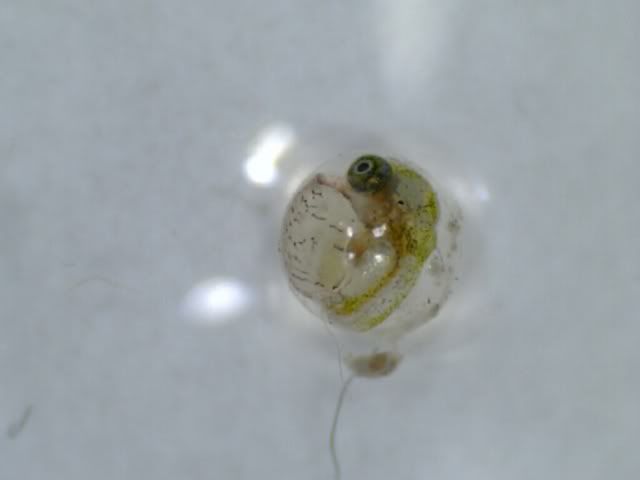
[color=red]Day 16[/color] The eye is probably not far off being fully formed, then I suspect we can look forward to it bursting free from the egg membrane.
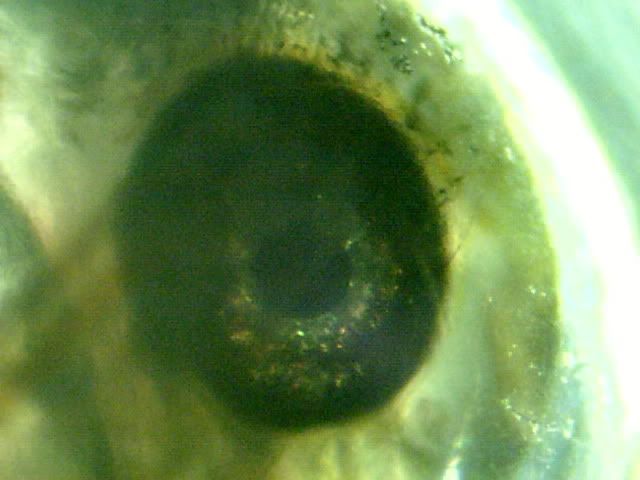
A close up of the opalescence around the iris
http://www.youtube.com/watch?v=sDBh_J8ivqE#
Tonight I thought we would draw back a little and use a smaller scope to give you some footage of the whole egg.
Notice the heartbeat to the left of the eye.
Remember the little lifeforms from earlier, living on the outskirts of the egg, well they are still present
[url=http://www.youtube.com/watch?v=OpC4j31smNI#]http://www.youtube.com/watch?v=OpC4j31smNI#
Here we again look at the little bell flower (as I call it) Notice the turbulence it causes in such a small globule of water.
Hope you all are enjoying this little venture as much as I am. The ultimate would be to capture the actual hatching process of the fry from the egg, That will probably not happen with a non-annual egg such as this, but I still hope to study and acquire some more decent images and video footage before the actual event.
Regards
C

Le 21 mai 2011 à 21h27

Chromaphyo
Le 21 mai 2011 à 21h27
Merci pour ces très belles videos. Je trouve aussi que 16 jours, c'est beaucoup pour [i]Aphanius mento.[/i] A quelle température les oeufs sont ils maintenus ?
Les videos sont prises avec un microscope Bresser à écran LCD comme celui-ci ?: http://www.astroshop.de/fr/microscopes-numeriques-avec-oculaire-pc/bresser-microscope-digital-lcd/p,12855
Les videos sont prises avec un microscope Bresser à écran LCD comme celui-ci ?: http://www.astroshop.de/fr/microscopes-numeriques-avec-oculaire-pc/bresser-microscope-digital-lcd/p,12855

Le 21 mai 2011 à 21h52

BigC
Le 21 mai 2011 à 21h52
Salut(Hé)
Je garde mon Aphanius mento dans des réservoirs(chars) non chauffés et des pots. Qui expliquerait pourquoi les restes frits plus longs dans l'oeuf. Je dois essayer de stocker aux intérimaires plus chauds pour voir la différence.
Le microscope à cristaux liquides Bresser auquel vous vous référez est exactement celui que j'ai.
Merci de vos commentaires
Respects
Colin
Je garde mon Aphanius mento dans des réservoirs(chars) non chauffés et des pots. Qui expliquerait pourquoi les restes frits plus longs dans l'oeuf. Je dois essayer de stocker aux intérimaires plus chauds pour voir la différence.
Le microscope à cristaux liquides Bresser auquel vous vous référez est exactement celui que j'ai.
Merci de vos commentaires
Respects
Colin

Le 21 mai 2011 à 23h03

pascal17
Le 21 mai 2011 à 23h03
BigC
a écrit le 21 mai 2011 à 21h52 Salut(Hé)
Je garde mon Aphanius mento dans des réservoirs(chars) non chauffés et des pots. Qui expliquerait pourquoi les restes frits plus longs dans l'oeuf. Je dois essayer de stocker aux intérimaires plus chauds pour voir la différence.
Le microscope à cristaux liquides Bresser auquel vous vous référez est exactement celui que j'ai.
Merci de vos commentaires
Respects
Colin
Bon, alors là Colin,c'est pas sûr que tout le monde comprenne.... ;). Voilà ce que moi je comprends:
frit = fry = alevin
restes = resting = dont le développement est stoppé ou en diapause.
=> les restes frits = resting fry = alevin qui ne parvient pas à éclore (literal translation of "les restes frits" : fried leftovers :D)
Tu veux peut-être dire:
"Je garde mon Apahanius mento dans des bacs non chauffés et des pots. Ce qui expliquerait pourquoi les alevins restent plus longtemps dans l'oeuf. Il faut que j'essaye de les conserver à des niveaux plus chauds [de la fishroom?] pour voir la différence."

Le 22 mai 2011 à 21h00

BigC
Le 22 mai 2011 à 21h00
[b][color=red]Pascal, I am using Google Translate and Reverso and both do not fully translate properly. I hope you are still able to follow and understand my article...[/color][/b]
[b]Restless[/b]....
Today we see the embryo is perhaps fully formed. One more discovery to report though. I cannot be sure, but I think I may have located signs of this little buddy's embryonic respiration system (gill movement) I may be wrong, and I'm sure someone will and should correct me if I am, but as you will see from the video below it sure looks like it could be. This egg, along with it's counterparts are being kept in an unheated integral garage where night-time temperatures will fluctuate, which would probably explain the delay in hatching times.
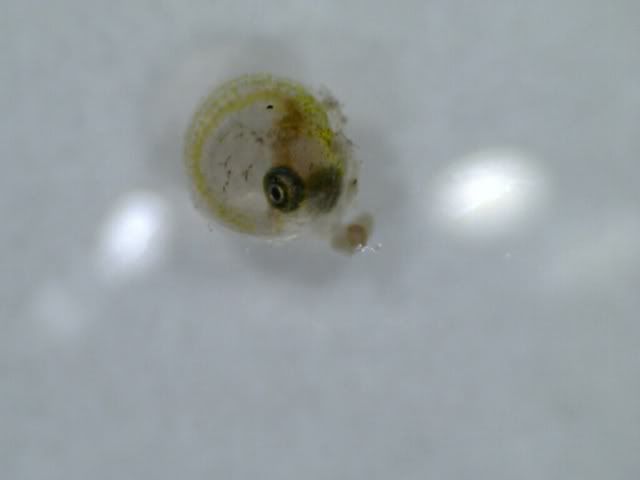
[color=red]Day 17[/color] On the face of things, I believe we shouldn't have too much longer to wait
A couple of videos from today...
Aphanius mento Embryo day 17
This first one shows the embryo with it's tiny heart beating away, notice it trying to make itself more comfortable by twitching about. :lol:
[url=http://www.youtube.com/watch?v=mqTwCIwUPdA#]Early embryonic respiratory system?
The second clip may or may not be early signs of a gill cover, opening and closing as part of the embryo's respiration system...What do you think? (is it or isn't it). The heart muscle is to the right of this clip.
Again thanks for dropping by.
Regards
C
[b]Restless[/b]....
Today we see the embryo is perhaps fully formed. One more discovery to report though. I cannot be sure, but I think I may have located signs of this little buddy's embryonic respiration system (gill movement) I may be wrong, and I'm sure someone will and should correct me if I am, but as you will see from the video below it sure looks like it could be. This egg, along with it's counterparts are being kept in an unheated integral garage where night-time temperatures will fluctuate, which would probably explain the delay in hatching times.

[color=red]Day 17[/color] On the face of things, I believe we shouldn't have too much longer to wait
A couple of videos from today...
Aphanius mento Embryo day 17
This first one shows the embryo with it's tiny heart beating away, notice it trying to make itself more comfortable by twitching about. :lol:
[url=http://www.youtube.com/watch?v=mqTwCIwUPdA#]Early embryonic respiratory system?
The second clip may or may not be early signs of a gill cover, opening and closing as part of the embryo's respiration system...What do you think? (is it or isn't it). The heart muscle is to the right of this clip.
Again thanks for dropping by.
Regards
C

Le 23 mai 2011 à 20h58

BigC
Le 23 mai 2011 à 20h58
[b]Awareness[/b].....
Today, as we are still kept waiting, I believe that the embryo/fry within the egg is now fully aware of life outside its prison.
As I studied the egg this evening, the eyes of the fry have become very animated, they seem to follow anything that moves around the outer casing of the egg, mostly the minute lifeforms we've seen in earlier footage. The hatch cannot be too far away now, the fry now equipped with a sense of its surroundings would certainly bare that point out.
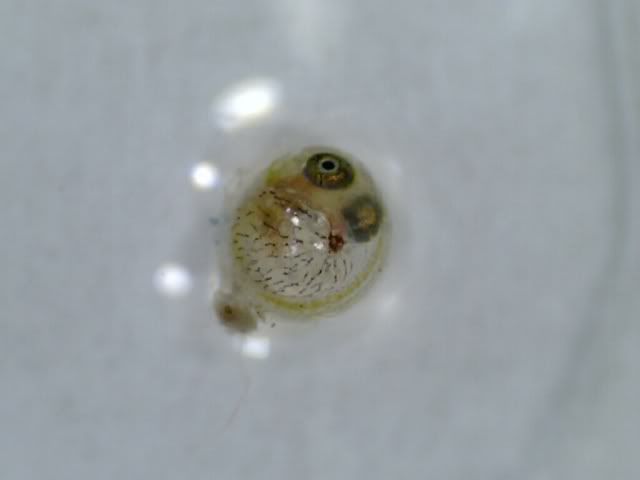
[color=red]Day 18[/color]....and still we wait
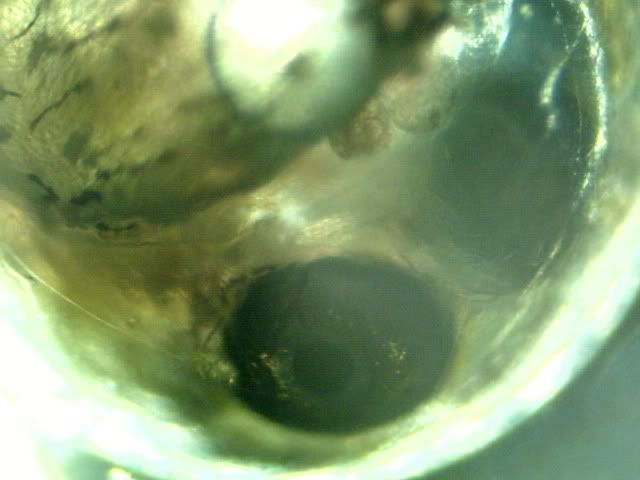
From the microscope, big eyes and big heart
Aphanius awareness
Having a little peek.
[url=http://www.youtube.com/watch?v=ctdlTZe_gV4#]Aphanius mento Embryo Day 18
The clip that I hope will prove that this fry is very aware of it's surroundings.
I'm sitting here tonight like some mad fool hoping that this fry will burst free from the egg of which I hope against all odds to capture :lol:
Realistically I know that this is probably impossible...as the big event could happen any-time day or night, no harm in trying though.
Again thanks for looking guys, hopefully it will all be over soon.
Regards
C
Today, as we are still kept waiting, I believe that the embryo/fry within the egg is now fully aware of life outside its prison.
As I studied the egg this evening, the eyes of the fry have become very animated, they seem to follow anything that moves around the outer casing of the egg, mostly the minute lifeforms we've seen in earlier footage. The hatch cannot be too far away now, the fry now equipped with a sense of its surroundings would certainly bare that point out.

[color=red]Day 18[/color]....and still we wait

From the microscope, big eyes and big heart
Aphanius awareness
Having a little peek.
[url=http://www.youtube.com/watch?v=ctdlTZe_gV4#]Aphanius mento Embryo Day 18
The clip that I hope will prove that this fry is very aware of it's surroundings.
I'm sitting here tonight like some mad fool hoping that this fry will burst free from the egg of which I hope against all odds to capture :lol:
Realistically I know that this is probably impossible...as the big event could happen any-time day or night, no harm in trying though.
Again thanks for looking guys, hopefully it will all be over soon.
Regards
C

Le 24 mai 2011 à 23h24

BigC
Le 24 mai 2011 à 23h24
[b]The Waiting Game[/b]....
Still the fry is unwilling to break free, The circulatory system seems to have darkened somewhat today deeper red and yellow colouration. The heart continues to pump and the eyes are ever vigilant. They adjust to the light and dark and anything that moves in close proximity. Every so often the fry gives, what I can only describe as a huge gasp or exhale, this expands the sac and the fry moves or twitches within its casing. I wonder if one of these large exhales (so to speak) is the mechanism it uses to rupture the egg, when the time comes.
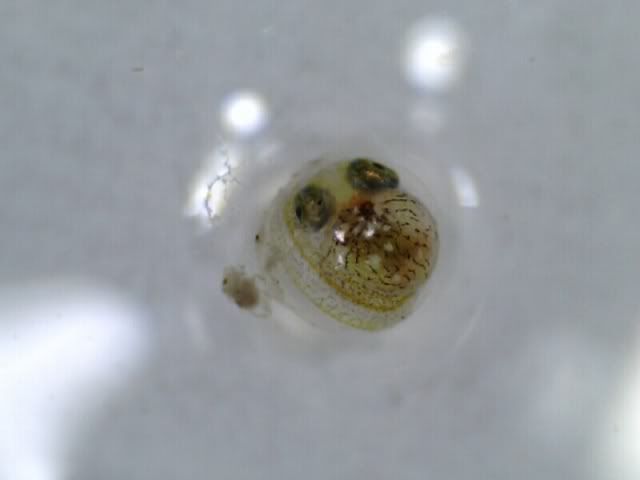
[color=red]Day 19[/color] The heart and surrounding circulatory system has taken on a deeper red colouration.
Hatching surely must be imminent.
Aphanius mento Embryo Day 19
Still hanging on in there!
Short and sweet tonight folks, just got in from work...been a long day.
Regards
C
Still the fry is unwilling to break free, The circulatory system seems to have darkened somewhat today deeper red and yellow colouration. The heart continues to pump and the eyes are ever vigilant. They adjust to the light and dark and anything that moves in close proximity. Every so often the fry gives, what I can only describe as a huge gasp or exhale, this expands the sac and the fry moves or twitches within its casing. I wonder if one of these large exhales (so to speak) is the mechanism it uses to rupture the egg, when the time comes.

[color=red]Day 19[/color] The heart and surrounding circulatory system has taken on a deeper red colouration.
Hatching surely must be imminent.
Aphanius mento Embryo Day 19
Still hanging on in there!
Short and sweet tonight folks, just got in from work...been a long day.
Regards
C

Le 25 mai 2011 à 22h46

BigC
Le 25 mai 2011 à 22h46
[b]Getting out and about.....[/b]
Just the one video tonight guys...Thats right...the conclusion to 20 days work. The fry has hatched.
I sat over this egg this evening for two hours, I could sense the big moment was going to happen. Working through computer freezes etc I have managed to capture most of the events as they happened. Although I didn't quite manage to get the money shot as it were, I captured, as best I could, everything leading up to and after the rupturing of the egg.
The fry had been in a heightened state of restlessness all evening, it's little heart was pumping harder than ever. There seemed to be an escape of fluids from inside the egg so that the fry was no longer surrounded by its moisture sac. It tossed and turned for over an hour, the moment of hatching was upon us, no going back....all of a sudden the fry burst free, it wasn't a gradual thing, rather it was like an explosion and the fry shot across the slide. I have tried to slow things down on the video but it was really way to quick...blink and you missed it.
So without further adieu I give you the final conclusion to this lengthy thread, all that is left for me to do now is to thank all of you who tuned in each evening to catch up on the events in progress. I hope this has shown some insight into the goings on in the day in the life of a Eurasian killifish embryo.
Aphanius mento Embryo Day 20.wmv
Thanks for watching and I hope you have enjoyed following this thread as much as I have producing it.
Regards
Colin
Just the one video tonight guys...Thats right...the conclusion to 20 days work. The fry has hatched.
I sat over this egg this evening for two hours, I could sense the big moment was going to happen. Working through computer freezes etc I have managed to capture most of the events as they happened. Although I didn't quite manage to get the money shot as it were, I captured, as best I could, everything leading up to and after the rupturing of the egg.
The fry had been in a heightened state of restlessness all evening, it's little heart was pumping harder than ever. There seemed to be an escape of fluids from inside the egg so that the fry was no longer surrounded by its moisture sac. It tossed and turned for over an hour, the moment of hatching was upon us, no going back....all of a sudden the fry burst free, it wasn't a gradual thing, rather it was like an explosion and the fry shot across the slide. I have tried to slow things down on the video but it was really way to quick...blink and you missed it.
So without further adieu I give you the final conclusion to this lengthy thread, all that is left for me to do now is to thank all of you who tuned in each evening to catch up on the events in progress. I hope this has shown some insight into the goings on in the day in the life of a Eurasian killifish embryo.
Aphanius mento Embryo Day 20.wmv
Thanks for watching and I hope you have enjoyed following this thread as much as I have producing it.
Regards
Colin

Le 25 mai 2011 à 23h04

pascal17
Le 25 mai 2011 à 23h04
Congrats :) There aren't too many videos capturing the hatching of non-annual killifishes. And your comments are very informative. Thanks for this thread.
Vous avez besoin d'aide ?
Faîtes une recherche sur le forum
148257 messages, 7862 discussions pour répondre à toutes vos questions...
